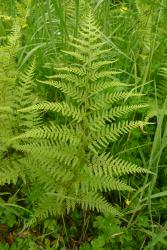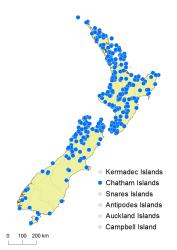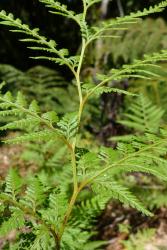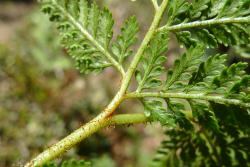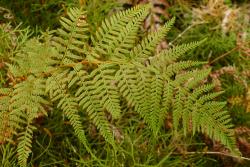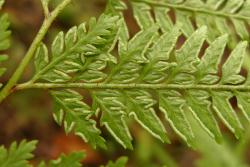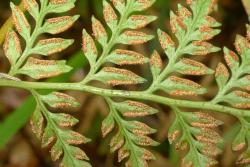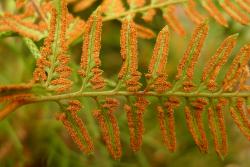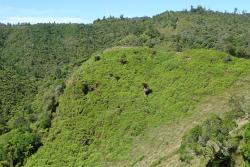- ≡ Pteris scaberula A.Rich., Essai Fl. Nouv.-Zél., 82, t. 11 (1832)
- ≡ Allosorus scaberulus (A.Rich.) C.Presl, Tent. Pterid. 154 (1836)
- ≡ Ornithopteris scaberula (A.Rich.) J.Sm., Hist. Fil. 299 (1875)
- = Pteris microphylla A.Cunn., Companion Bot. Mag. 2: 366 (1837)
Rhizomes long-creeping, 1–4 mm diameter, with stipes arising 10–165 mm apart; bearing chestnut-brown, multicellular, non-glandular hairs up to 4 mm long. Fronds 150–1175 mm long. Stipes 25–560 mm long, 1–2.5 mm diameter, red-brown or chestnut-brown, bearing red-brown, multicellular, non-glandular hairs up to 5 mm long. Rachises chestnut-brown, becoming yellow-brown distally, zigzag, bearing red-brown, multicellular, non-glandular hairs up to 2 mm long, and very short yellowish glandular hairs up to 0.1 mm long (becoming white with age). Laminae 3–4-pinnate, ovate or elliptic, tapering to a short pinnatisect apex, 100–780 mm long, 45–430 mm wide, yellow-green on both surfaces, coriaceous; abaxial surface of costae bearing red-brown, multicellular, non-glandular hairs up to 1 mm long; costae and both lamina surfaces bearing very short, yellowish, glandular hairs. Primary pinnae in 15–30 pairs below pinnatisect apex, widely spaced proximally, overlapping distally, narrowly winged distally except in the most divided fronds; distal primary pinnae narrowly ovate; proximal primary pinnae ovate; the longest at or below the middle, 25–265 mm long, 11–90 mm wide, apices acute or acuminate, bases stalked. Secondary pinnae decreasing gradually in length along primary pinnae to the distal end, narrowly winged throughout; the longest narrowly ovate or ovate, 9–60 mm long, 4–23 mm wide, apices acute or acuminate, bases short-stalked; fertile secondary pinnae often with a long undivided terminal segment. Tertiary pinnae narrowly ovate or narrowly oblong, 3–13 mm long, 1–4 mm wide, apices acute or obtuse, bases short-stalked, margins entire on fertile pinnae, deeply divided on sterile pinnae, sometimes into quaternary pinnae. Sori and indusia almost continuous along margins of ultimate segments.
Paesia scaberula can be recognised by its long-creeping rhizomes, highly divided and slightly dimorphic laminae bearing glandular hairs, zigzag rachises, and sori that are more or less continuous around the lamina margins, protected by the inrolled lamina margin and a true inner indusium. The sterile pinnae are more divided than the fertile pinnae.
Very occasional crested forms are found with the apices of the pinnae divided multiple times.
North Island: Northland, Auckland, Volcanic Plateau, Gisborne, Taranaki, Southern North Island.
South Island: Western Nelson, Sounds-Nelson, Marlborough, Westland, Canterbury, Otago, Southland, Fiordland.
Three Kings Islands, Chatham Islands, Stewart Island.
Altitudinal range: 0–1200 m.
Paesia scaberula is widespread in coastal, lowland and montane areas of the North Island from Te Paki south, reaching over 1200 m on Mt Honokawa in the Raukūmara Range. In the South Island it occurs commonly in coastal and lowland areas of the northern half of the island, but elsewhere it is largely confined to coastal districts and is absent from drier inland regions. It reaches 1200 m near Hokitika. It also occurs on the Chatham Islands.
Paesia scaberula often forms extensive populations in reverting pasture, grassy clearings, and on stabilised dunes and waste ground. It also grows in roadside ditches and banks, along tracksides, in light gaps in forest, on rotten wood, on swamp and forest margins, in pākihi, along stream beds and hot streams, in modified tussock, and on scree. It mostly grows in the open, but also occurs under podocarp, broadleaved and beech forest, under mānuka and kānuka, in coastal scrub, under pine plantations and with bracken.



